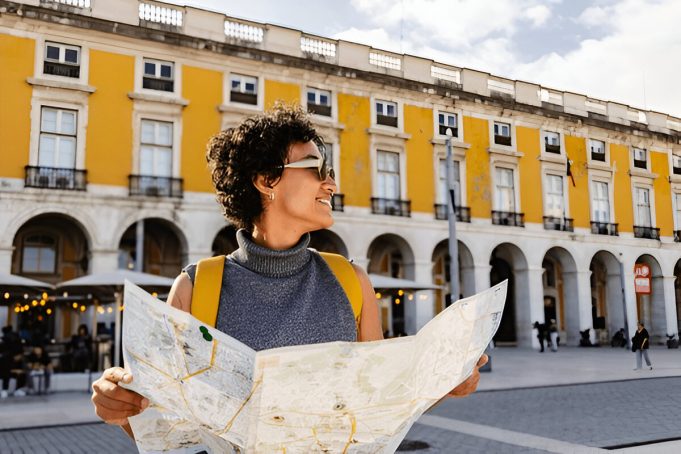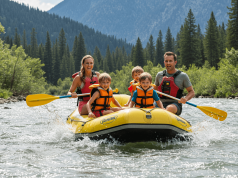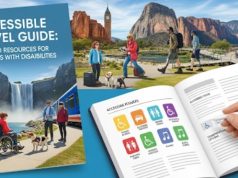The Call of the Horizon: An Introduction to Travelling Solo
There’s a unique hum in the air just before you step into the unknown. It’s a blend of exhilarating anticipation and a quiet, fluttering nervousness. This feeling is magnified tenfold when you’re about to embark on your first solo trip. The idea of travelling alone is a powerful one, often romanticised as the ultimate journey of self-discovery. It’s a path to unparalleled freedom, a chance to write your own story, page by page, in a land where no one knows your name. Yet, for every daydream of wandering through ancient cobblestone streets alone, there’s a shadow of doubt. Is it safe? Will I be lonely? Can I really do this?
The answer is a resounding yes. This guide is your comprehensive companion, designed to transform those anxieties into confidence. We’re here to walk you through every step, from the initial spark of an idea to the moment you return home, forever changed. Travelling solo isn’t just about seeing the world; it’s about seeing yourself in a new light. It’s about proving that you are more capable, resilient, and adventurous than you ever imagined. So, take a deep breath. The horizon is calling, and you’re about to answer.
Why Travel Solo? The Unmatched Benefits of Your Own Company

Before we dive into the “how,” let’s solidify the “why.” What makes travelling alone such a transformative experience? It goes far beyond simply not having to compromise on dinner plans.
- Absolute Freedom: This is the most intoxicating benefit. Your itinerary is entirely your own. Wake up at noon? Do it. Spend six hours in one museum? Go for it. Change your entire plan on a whim because you met some interesting people? You can. You are the master of your own adventure, and every decision is yours to make.
- Profound Self-Discovery: When you’re alone, stripped of the familiar roles you play at home, you have the space to truly connect with yourself. You’ll learn to trust your intuition, solve problems independently, and discover a well of inner strength you never knew you had.
- Confidence Tsunami: Navigating a foreign country, overcoming language barriers, and successfully making your way from point A to point B on your own is an incredible confidence booster. Each small victory builds upon the last until you feel like you can conquer anything.
- Enhanced Sensory Experience: Without the distraction of a travel companion, your senses are heightened. You’ll notice the intricate details of the architecture, the specific spices in the street food, and the subtle melody of a foreign language. The world becomes more vibrant.
- Genuine Connections: It may seem counterintuitive, but solo travellers are often more approachable. You’re more likely to strike up conversations with locals and other travellers, leading to more authentic and meaningful connections than if you were in a closed-off group.
Step 1: Choosing Your Perfect First Solo Destination
The world is vast, and choosing where to go first can feel overwhelming. The key is to pick a destination that aligns with your comfort level and interests, setting yourself up for success. Here’s what to consider:
Key Factors for First-Timers
- Safety: This is non-negotiable. Look for countries with a low crime rate and a stable political climate. Resources like the U.S. Department of State’s travel advisories or the Global Peace Index are excellent starting points. Pay special attention to advice for female solo travelers if applicable.
- Tourist Infrastructure: For a first trip, it helps to go somewhere with a well-trodden tourist path. This means reliable public transportation, a variety of accommodation options (like hostels, which are great for meeting people), and plenty of tours and activities that are easy to join.
- Language Barrier: While you don’t need to be fluent, choosing a country where English is widely spoken or where the tourism industry is accustomed to English speakers can significantly reduce stress on your first solo outing.
- Budget: Be realistic about what you can afford. Southeast Asia and Eastern Europe are famously budget-friendly, while Western Europe and Australia will require a more significant investment.
Top Destination Ideas for First-Time Solo Travellers
1. Southeast Asia (Thailand, Vietnam): Incredibly budget-friendly with a legendary backpacker trail. The food is divine, the people are friendly, and it’s very easy to meet other travellers.
2. Portugal: Safe, affordable for Western Europe, and stunningly beautiful. From the charming streets of Lisbon to the beaches of the Algarve, it offers a perfect blend of culture, history, and relaxation.
3. New Zealand: An adventure-lover’s paradise. It’s exceptionally safe, English-speaking, and has an incredible infrastructure for tourists, especially those interested in hiking and outdoor activities.
4. Ireland: Known for its overwhelming friendliness (the “craic”), cozy pubs, and breathtaking landscapes. It’s easy to navigate, and you’ll never be short of a conversation.
5. Japan: A fantastic choice if your priority is safety and efficiency. It’s one of the safest countries in the world, the public transport is second to none, and the culture is a fascinating blend of ancient and futuristic. While there is a language barrier, people are generally very helpful.
Step 2: Planning and Budgeting Like a Pro
Once you have a destination, the real planning begins. A solid plan doesn’t restrict your freedom; it provides a safety net that allows you to be spontaneous without being reckless.
Crafting Your Budget
Your budget will dictate the length and style of your trip. Break it down into four main categories:
- Pre-Trip Expenses: Flights, travel insurance (absolutely essential!), visas, and any necessary gear or vaccinations.
- Accommodation: Research the average cost per night for hostels, guesthouses, or budget hotels in your destination. Hostels are not just for saving money; their common areas are social hubs for meeting fellow travelers.
- Daily Expenses: This is your per diem for food, local transport, activities, and entrance fees. Research average costs online. A good rule of thumb is to slightly overestimate.
- Contingency Fund: Set aside at least 15-20% of your total budget for emergencies. This could be for a missed flight, a medical issue, or a once-in-a-lifetime opportunity you just can’t pass up.
Booking Tip: Book your first one or two nights of accommodation in advance. This gives you a place to land and get your bearings before you start making more spontaneous decisions.
Step 3: Packing Smart for One
Packing for a solo trip is an art form. You are your own porter, so every ounce counts. The goal is to be prepared without being weighed down.
The Essentials Checklist
- Travel Documents: Passport, visas, flight tickets, travel insurance details. Keep digital copies in your email/cloud and physical photocopies separate from the originals.
- Money: A mix of cash and cards. Have at least two different bank cards in case one is lost or blocked.
- Backpack or Suitcase: A travel backpack is often more versatile for navigating varied terrain, but a spinner suitcase is fine for city-based trips. Choose what’s most comfortable for you to manage alone.
- Clothing: Pack versatile, layerable clothes in neutral colours. Think merino wool (moisture-wicking, odour-resistant), quick-dry fabrics, and items that can be dressed up or down.
- Electronics: Phone, portable power bank (a lifesaver!), universal travel adapter, headphones.
- First-Aid Kit: A small kit with pain relievers, band-aids, antiseptic wipes, blister treatment, and any personal medications.
- Security: A padlock for hostel lockers and a portable door stop or door jammer for added peace of mind in your room.
What to Leave Behind
Leave expensive jewelry, flashy designer clothes, and anything you would be devastated to lose. Pack travel-sized toiletries or, even better, switch to solid shampoo and conditioner bars to save space and avoid liquid spills.
Staying Safe and Savvy on the Road
Safety is the number one concern for most aspiring solo travelers, and rightly so. However, with preparation and awareness, you can mitigate most risks and travel with confidence.
- Trust Your Intuition: This is your most powerful tool. If a situation or a person feels off, it probably is. Remove yourself from the situation immediately. Don’t worry about being rude; your safety is the priority.
- Share Your Itinerary: Leave a copy of your general itinerary, including flight details and accommodation info, with a trusted friend or family member at home. Check in with them regularly.
- Be Aware of Your Surroundings: Always be mindful of who and what is around you. Avoid walking alone at night in unlit or unfamiliar areas. Don’t wear headphones in both ears when you’re out and about.
- Secure Your Valuables: Don’t flash expensive electronics or large amounts of cash. Keep your passport, extra cash, and cards locked in your accommodation. Carry a day bag that is difficult to pickpocket (e.g., a crossbody bag worn in front of you).
- Research Local Scams: A quick Google search for “common scams in [your destination]” can save you a lot of trouble. Be wary of strangers who are overly friendly or who try to distract you.
- Drink Responsibly: It’s fine to enjoy yourself, but always keep your wits about you. Never leave your drink unattended and know your limits.
Embracing Solitude & Making Connections

The biggest fear after safety is often loneliness. But being alone doesn’t have to mean being lonely. In fact, learning to enjoy your own company is one of the greatest gifts of solo travel.
How to Enjoy Being Alone
Dine with confidence. Bring a book or a journal to a restaurant. Sit at a cafe and just people-watch. Wander aimlessly through a neighborhood with no goal other than to observe. These quiet moments of reflection are where the magic happens.
How to Meet People (When You Want To)
- Stay in Hostels: The easiest way to meet other travellers. Hang out in the common room, join a hostel-organised pub crawl, or just ask the person in the bunk next to you where they’re from.
- Join a Free Walking Tour: These are offered in most major cities. You’ll learn about the city and have a natural opportunity to chat with others in your group.
- Take a Class: Sign up for a local cooking class, a surf lesson, or a dance workshop. It’s a great way to meet people who share your interests.
- Use Technology: Apps like Meetup or backpacker-focused Facebook groups can connect you with events and other travelers in your area.
Your Adventure Awaits
The journey of a thousand miles begins with a single step. For you, that step might be researching destinations, starting a savings account, or simply giving yourself permission to have this adventure. The fear and uncertainty you feel are normal; they are the gatekeepers to an experience that will fundamentally change you for the better. You will return with more than just souvenirs and photographs. You will come back with stories of your own resilience, with a deeper understanding of the world, and with the unshakable knowledge that you are capable of navigating this beautiful, chaotic world entirely on your own terms.
So, book the ticket. Pack the bag. Embark on your first solo adventure. You are ready.







